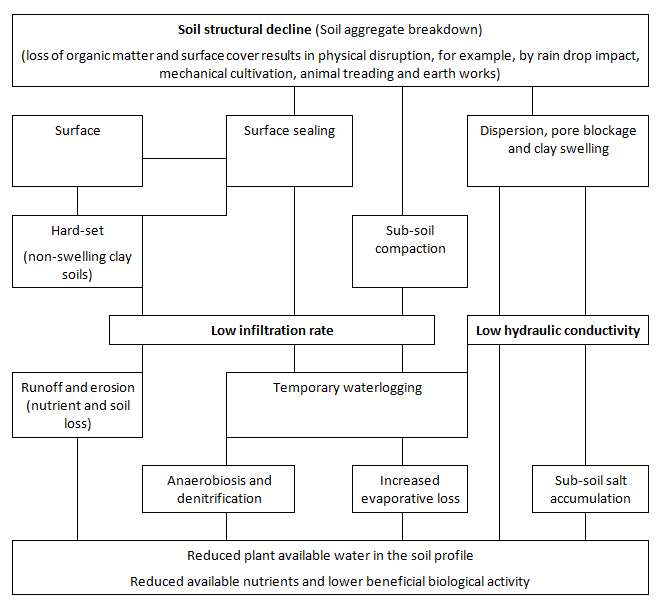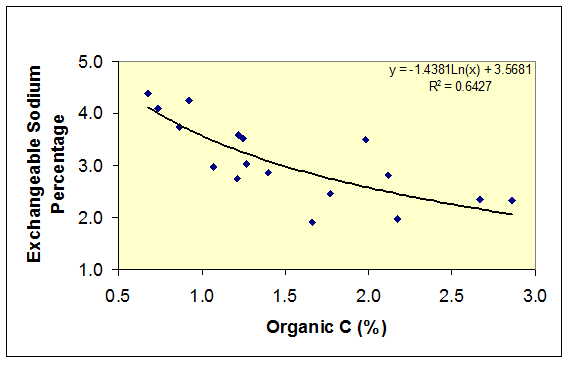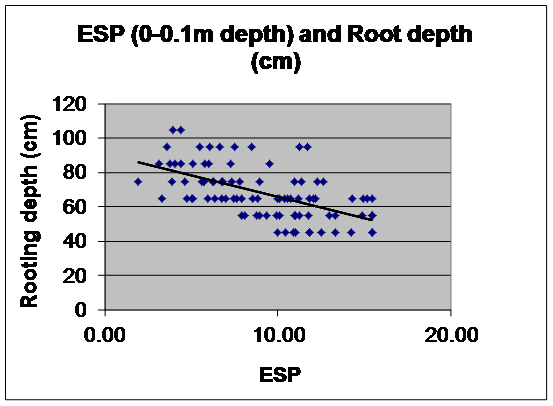Soil structural decline and organic matter in the northern grains region
Author: Ram Dalal, Department of Science, Information Technology, Innovation and the Arts, School of Agriculture and Food Sciences, University of Queensland | Date: 25 Aug 2014
Take home message
- Good soil structure, with large pores is required for infiltration, aeration, and root growth
- Well- structured soil has plenty of crumbly aggregates; organic matter is essential for these
- Northern Grains region cracking clay soils have good soil structure in their native state
- Organic matter decline from cultivation and cropping has resulted in soil structural decline
- Soil structural decline reduces infiltration, seedling establishment and root growth
- Soil structural decline is also associated with surface crusting, and sub-surface compaction
- Increasing and maintaining soil organic matter reverses structural decline
- Rotation with fine root crops / pasture adds organic matter and improves soil structure
- Increasing and maintaining plant residue cover improves infiltration and biological activity
- Reducing tillage improves the continuity of soil pores and maintains infiltration and increases plant available water at sowing
- Increasing plant available water and nitrogen supply (from soil and fertiliser) increases both water use efficiency and nitrogen use efficiency
- Avoid excessive soil compaction by eliminating heavy machinery traffic when wet
- For surface crusting soils gypsum and / or other amendments may be required
A good cropping soil needs to have a ‘good soil structure’, that is, soil particles are bound together or aggregated. Soil structure is the spatial arrangement of soil pores and hence pore space between bound soil particles or aggregates. Soil pores vary from >0.3 mm (large pores or macropores)), 0.06 – 0.03 mm (small pores), to <0.03 mm (fine pores). Large pores are required for rapid infiltration, aeration and drainage; small pores are required for water storage, root growth and microbial activity while fine pores for soil tilth. Soil organic matter, clay particles, carbonates and iron and aluminium oxides are the bonding agents, which form and stabilise aggregates. A well-structured soil crumbles easily when dry and does not adhere to cultivating tynes when wet. It is prone to structural degradation when soil organic matter is lost. Good management practices can restore soil organic matter and soil structure to a variable extent in different soils.
Soil structure has a major influence on water entry and movement within soil, air movement, seedling emergence, root growth, and biological activity. For example, a good-structured, well aggregated soil facilitates seedling emergence and infiltration, prevents soil sealing and formation of surface crust. Enhanced water infiltration reduces runoff and water erosion, and therefore, increases the soil water available to crops. Thus, a well aggregated soil allows smooth flow of water, air and nutrients, promotes root growth, aerobic microbial activity, and earthworms and other fauna activity.
Organic matter in soil provides both aggregate forming and stabilising agents. It provides nuclei, for example, polysaccharides to which clay particles are attracted, and provide glue that binds these particles together to form aggregates, generally through cation (calcium, aluminium, iron) bonding.
Plant roots growing in soil creates larger pores as they expand. Also, growing roots produce root exudates to which clay particles are attracted or glued as soil dries due to water used by the crop. In general, greater are the fine roots better is the soil structure, for example in soil under grass pasture.
Both saprophytic and mycorrhizal fungi grow in smaller pores than plant roots. These fungi bind soil aggregates by their filamentous hyphae (mycelium) mechanically and stabilise the soil pores through organic substrates they produce. The vesicular-arbuscular mycorrhizae (VAM), which are associated with the roots of cereal crops, grasses and legumes, have the ability also to extend into fine pores, extract phosphorus and zinc for the host plant as well as bind soil particles into aggregates.
Soil structural decline or aggregate breakdown
In the northern grains region, mostly cracking clay soils (Vertosols) have good soil structure in their native state. When these soils are brought under cultivation and cropping soil structure declines. Soil structure decline occurs due to the loss of organic matter which is the main binding agent for large aggregates (macroaggregates) >0.25 mm (250 micron or µm) that provide large pores. If the soil under native state is also sodic, loss of organic matter under cropping and cultivation exasperates the soil structure decline.
Consequences of soil structure decline or aggregate breakdown are shown in Figure 1. Primary consequences of aggregate breakdown are poor infiltration rate (soil surface) and low hydraulic conductivity (within the soil profile). Soil with poor infiltration rate does not soak up rainfall rapidly resulting in either runoff and erosion and water loss and nutrient loss or waterlogging creating nitrogen loss conditions through denitrification or gaseous nitrogen loss. Aggregate dispersion, pore blockage and clay swelling results in low hydraulic conductivity, that is, slow water movement within the soil. Low hydraulic conductivity results in temporary waterlogging, increased evaporative loss and sub-soil salt accumulation (subsoil constraints). Overall consequences of soil structural decline or aggregate breakdown are reduced plant available water in the soil profile, reduced available nutrients and lower beneficial biological activity.

Figure 1. Effects of soil aggregate breakdown on soil fertility degradation through a number of interrelated degradative processes (organic matter loss, runoff and erosion, nutrient loss, poor air-water relationships and reduced plant available water stored in the soil profile). Extended and adapted from Coughlan (1984) and Cook (1988).
Connolly et al (1997) showed that infiltration rates decreased as soil organic matter lost, which was related to the older age of cultivation and cropping. Dalal et al (2003) found that exchangeable sodium percentage (ESP) in the 0-0.1 m depth (more is the ESP greater is aggregate breakdown) increased as soil organic matter decreased (Figure 2a), also the rooting depth decreased (Figure 2b), and hence lower the amount of plant available water in soil.
(a)

(b)

Figure 2. Exchangeable sodium percentage (ESP) increases as organic matter decreases (a) and rooting depth decreases (b).
Management options to restore soil structure (increase soil aggregation)
Restoration of soil structure or increasing soil aggregation includes:
- Increase soil organic matter, either through crop rotation which includes pasture phase or apply organic amendments, for example, feedlot manure
- Maintain soil surface cover, that is, leave crop residue on the soil surface
- Minimise soil disturbance, for example, practise minimum or no-till
- Reduce sodicity in the top soil layer by gypsum application, increasing organic matter and no-till practice
- In case of highly dispersive, surface-crusted soils increase pasture phase in the rotation
It is well established that pasture phase following cropping increases soil organic matter (Dalal et al, 1995), provided the soil has not become depleted in essential plant nutrients, for example phosphorus and zinc. In the latter, pasture growth is poor and does not add organic matter to the soil to any significant extent. Pasture phase that includes grasses also improves soil aggregation through fibrous roots.
Crop residue left on the soil surface protects it from raindrop impact, that is, reduced soil dispersion and increased infiltration (Foley et al., 1991), provides habitat for microbial and faunal activity, reduces water evaporation and returns plant nutrients for example potassium, calcium, phosphorus and nitrogen (Thomas et al., 2007a).
No-till combined with crop residue retention provides optimum conditions for infiltration, and improved hydraulic conductivity due to continuity of soil pores, generally better aeration and soil biological activity. Compared to the convention till, it may store 10-50 mm of extra plant available water during fallow (Thomas et al., 2007b) for the following crop.
In many grain cropping soils, although sodicity levels are not high, usually ESP below 10, the effects on soil dispersion are recorded as low as 5 or even lower than 5. In soils with high ESP values gypsum application has found to be useful and the benefits last over a number of crops. However, at low values, increasing organic matter levels through pasture phase or organic amendments is also effective.
Often crop water use is restricted due to the lack of essential plant nutrients. For example, in the long-term trials such as Warra, Billa Billa and Nindigully trials, water use and water use efficiency increased as nutrient supply increased (Dalal et al., 2013)(Figure 3a and b). In fact, water use efficiency and nitrogen use efficiency are positively related (Figure 4).
Therefore, management practices that improve or maintain soil structure, surface cover and no-till and appropriate nutrition leads to better water use and improved water use efficiency, which is critical for sustainable grain production in the rainfed, semi-arid subtropical northern grains region.
(a)

(b)

Figure 3. Water use efficiency increases with nitrogen application (1988-1998) at Warra (a), and (1996-2001) at Nindigully (b), Queensland. Results in the Billa Billa trial were similar.

Figure 4. Relationship between apparent grain nitrogen use efficiency (NUE) and water use efficiency (WUE) over 5 years of wheat cropping at Warra, Queensland.
References
Connolly RD, Freebairn DM, Bridge BJ (1997). Change in infiltration characteristics associated with cultivation history of soils in south-eastern Queensland. Australian Journal of Soil Research 35, 1341-1358.
Cook GD (1988). Degradation of soil structure under continuous cultivation on the Darling Downs, Queensland. Ph.D Dissertation, University of Queensland, Brisbane, Australia.
Coughlan KJ 1984. The structure of Vertisols. In: JW McGarity, EH Hoult, HB SO (eds) Properties and Utilisation of Cracking Clay Soils, pp. 87-96. Reviews in Rural Science No. 5, University of New England, Armidale, Australia.
Dalal RC, Eberhard R, Grantham T, Mayer DG (2003). Application of sustainability indicators, organic matter and electrical conductivity, to resource management in the northern grains region. Australian Journal of Experimental Agriculture 43, 253-259.
Dalal RC, Strong WM, Cooper JE, King AJ (2013). Relationship between water use and nitrogen use efficiency discerned by 13C discrimination and 15N isotope ratio in bread wheat grown under no-till. Soil Tillage Research 128, 110-118.
Dalal RC, Strong WM, Weston EJ Cooper JE, Lehane KJ, King AJ, Chicken CJ (1995). Sustaining productivity of a vertisol at Warra, Queensland, with fertilisers, no-till or legumes .1. Organic matter status. Australian Journal of Experimental Agriculture 37: 903-913.
Foley JL, Loch RJ, Glanville SF, Connolly RD (1991). Effects of tillage, stubble and rainfall energy on infiltration. Soil and Tillage Research 20, 45-55.
Thomas GA, Dalal RC, Standley J (2007a). No-till effects on organic matter, pH, cation exchange capacity, and nutrient distribution in a Luvisol in the semi-arid subtropics. Soil and Tillage Research 94, 295-304.
Thomas GA, Titmarsh GW, Freebairn DM, Radford BJ (2007b). No-tillage and conservation farming practices in grain-growing areas of Queensland. Australian Journal of Experimental Agriculture 47, 887-898.
Contact details
Ram Dalal
Department of Science, Information Technology, Innovation and the Arts, Qld
Ph: 07 3170 5766
Fx: 07 3170 5797
Email: Ram.Dalal@qld.gov.au
Was this page helpful?
YOUR FEEDBACK
